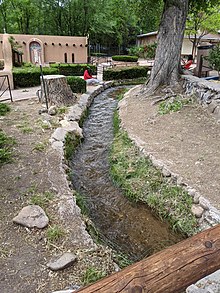
An acequia (Spanish: [aˈθekja]) or séquia (Catalan: [ˈsekiə, -a], also known as síquia [ˈsikiə, -a]) is a community-operated watercourse used in Spain and former Spanish colonies in the Americas for irrigation. Acequias are found in parts of Spain, the Andes, northern Mexico, and the modern-day American Southwest (northern New Mexico and southern Colorado).
Scholars describe acequias as "technological systems that are designed, maintained, and operated to meet a variety of productive goals, social services, and health needs, with the practice of irrigated agriculture being of paramount importance."[1] In the United States, the oldest acequias were established more than 400 years ago by Spanish colonizers. The traditional form of governance over acequias is the oldest form of European resource management still alive in the United States today.[2]
Acequias are filled by snow melt and rain to water orchards, gardens, and other agricultural fields. Other than watering crops, acequias have deep cultural significance for many Indigenous and Native communities in New Mexico and Colorado.
- ^ Rosenberg et al. (2020).
- ^ Cite error: The named reference
Romerowas invoked but never defined (see the help page).